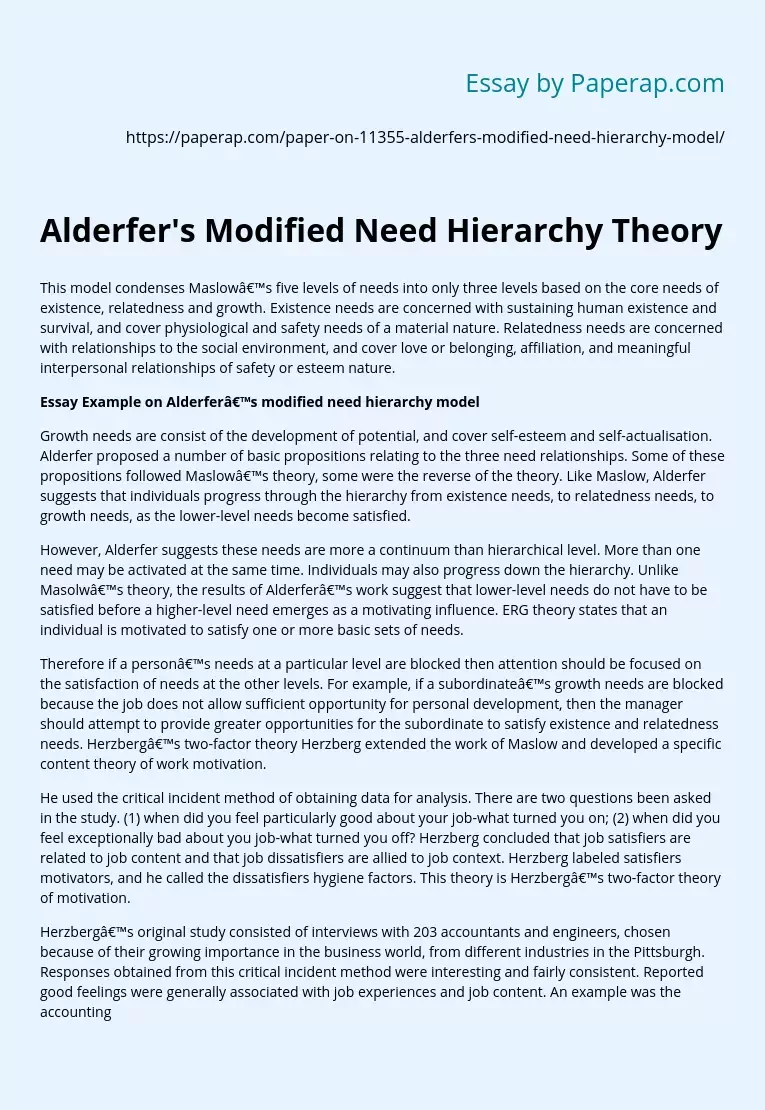Alderfer's Modified Need Hierarchy Theory
This model condenses Maslow’s five levels of needs into only three levels based on the core needs of existence, relatedness and growth. Existence needs are concerned with sustaining human existence and survival, and cover physiological and safety needs of a material nature. Relatedness needs are concerned with relationships to the social environment, and cover love or belonging, affiliation, and meaningful interpersonal relationships of safety or esteem nature.
Essay Example on Alderfer’s modified need hierarchy model
Growth needs are consist of the development of potential, and cover self-esteem and self-actualisation.
Alderfer proposed a number of basic propositions relating to the three need relationships. Some of these propositions followed Maslow’s theory, some were the reverse of the theory. Like Maslow, Alderfer suggests that individuals progress through the hierarchy from existence needs, to relatedness needs, to growth needs, as the lower-level needs become satisfied.
However, Alderfer suggests these needs are more a continuum than hierarchical level. More than one need may be activated at the same time.
Individuals may also progress down the hierarchy. Unlike Masolw’s theory, the results of Alderfer’s work suggest that lower-level needs do not have to be satisfied before a higher-level need emerges as a motivating influence. ERG theory states that an individual is motivated to satisfy one or more basic sets of needs.
Therefore if a person’s needs at a particular level are blocked then attention should be focused on the satisfaction of needs at the other levels. For example, if a subordinate’s growth needs are blocked because the job does not allow sufficient opportunity for personal development, then the manager should attempt to provide greater opportunities for the subordinate to satisfy existence and relatedness needs.
Herzberg’s two-factor theory Herzberg extended the work of Maslow and developed a specific content theory of work motivation.
He used the critical incident method of obtaining data for analysis. There are two questions been asked in the study. (1) when did you feel particularly good about your job-what turned you on; (2) when did you feel exceptionally bad about you job-what turned you off? Herzberg concluded that job satisfiers are related to job content and that job dissatisfiers are allied to job context. Herzberg labeled satisfiers motivators, and he called the dissatisfiers hygiene factors. This theory is Herzberg’s two-factor theory of motivation.
Herzberg’s original study consisted of interviews with 203 accountants and engineers, chosen because of their growing importance in the business world, from different industries in the Pittsburgh. Responses obtained from this critical incident method were interesting and fairly consistent. Reported good feelings were generally associated with job experiences and job content. An example was the accounting supervisor who felt good about given the job of installing new computer equipment.
He took pride in his work and was gratified to know that the new equipment made a big difference in the overall functioning of his department. Reported bad feeling, on the other hand, were generally associated with the surrounding or peripheral aspects of the job-the job context. An example of these feeling was related by an engineer whose first job was to keep tabulation sheets and manage the office when the boss was gone. It turned out that his boss was always too busy to train him and became annoyed when he tried to ask questions.
The engineer said that he was frustrated in this job context and that he felt like a flunky in a deaf-end job. The motivation-hygiene theory has extended Maslow’s hierarchy of need theory and is more directly applicable to the work situation. Herzberg’s theory suggests that if management is to provide positive motivation then attention must be given not only to hygiene factors, but also to the motivating factors. The work of Herzberg indicates that it is more likely good performance leads to job satisfaction rather than the reverse.
Alderfer's Modified Need Hierarchy Theory. (2019, Nov 27). Retrieved from https://paperap.com/paper-on-11355-alderfers-modified-need-hierarchy-model/

